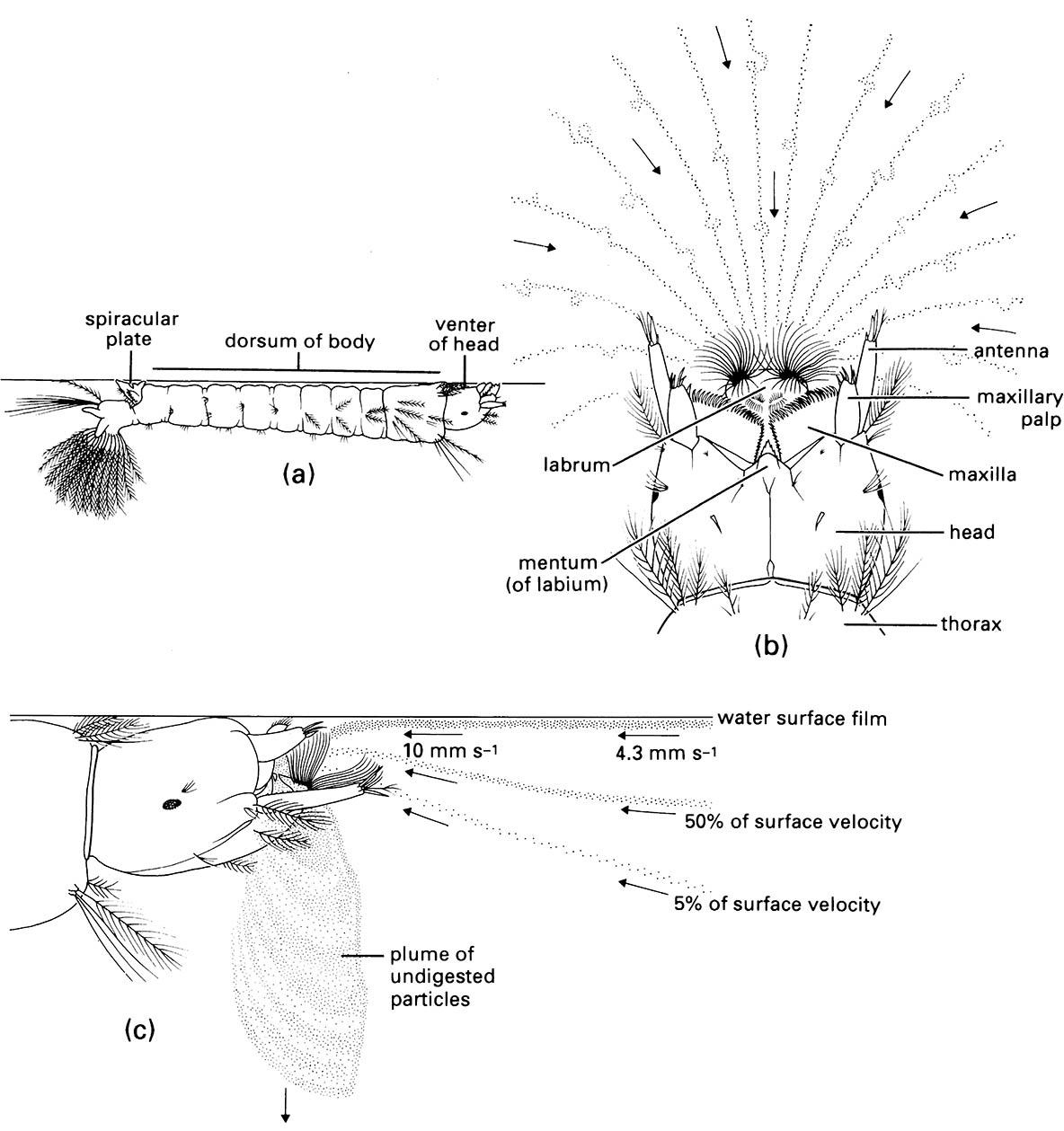10.4.2. Lentic adaptations
With the exception of wave action at the shore of larger bodies of water, the effects of water movement cause little or no difficulty for aquatic insects that live in lentic environments. However, oxygen availability is more of a problem and lentic taxa show a greater variety of mechanisms for enhanced oxygen uptake compared with lotic insects.
The lentic water surface is used by many more species (the neustic community of semi-aquatic insects) than the lotic surface, because the physical properties of surface tension in standing water that can support an insect are disrupted in turbulent flowing water. Water-striders (Hemiptera: Gerromorpha: Gerridae, Veliidae) are amongst the most familiar neustic insects that exploit the surface film (Box 10.6). They use hydrofuge (water-repellent) hair piles on the legs and venter to avoid breaking the film. Water-striders move with a rowing motion and they locate prey items (and in some species, mates) by detecting vibratory ripples on the water surface. Certain staphylinid beetles use chemical means to move around the meniscus, by discharging from the anus a detergent-like substance that releases local surface tension and propels the beetle forwards. Some elements of this neustic community can be found in still-water areas of streams and rivers, and related species of Gerromorpha can live in estuarine and even oceanic water surfaces (section 10.8).
Underneath the meniscus of standing water, the larvae of many mosquitoes feed (Fig. 2.16), and hang suspended by their respiratory siphons (Fig. 10.2), as do certain crane flies and stratiomyiids (Diptera). Whirligig beetles (Gyrinidae) (Fig. 10.8) also are able to straddle the interface between water and air, with an upper unwettable surface and a lower wettable one. Uniquely, each eye is divided such that the upper part can observe the aerial environment, and the lower half can see underwater.
Between the water surface and the benthos, planktonic organisms live in a zone divisible into an upper limnetic zone (i.e. penetrated by light) and a deeper profundal zone. The most abundant planktonic insects belong to Chaoborus (Diptera: Chaoboridae); these “phantom midges” undergo diurnal vertical migration, and their predation on Daphnia is discussed in section 13.4. Other insects such as diving beetles (Dytiscidae) and many hemipterans, such as Corixidae, dive and swim actively through this zone in search of prey. The profundal zone generally lacks planktonic insects, but may support an abundant benthic community, predominantly of chironomid midge larvae, most of which possess hemoglobin. Even the profundal benthic zone of some deep lakes, such as Lake Baikal in Siberia, supports some midges, although at eclosion the pupa may have to rise more than 1 km to the water surface.
In the littoral zone, in which light reaches the benthos and macrophytes can grow, insect diversity is at its maximum. Many differentiated microhabitats are available and physico-chemical factors are less restricting than in the dark, cold, and perhaps anoxic conditions of the deeper waters.

(a) The larva floating just below the water surface, with head rotated through 180° relative to its body (which is dorsum-up so that the spiracular plate near the abdominal apex is in direct contact with the air). (b) Viewed from above showing the venter of the he ad and the feeding current generated by setal brushes on the labrum (direction of water movement and paths taken by surface particles are indicated by arrows and dotted lines, respectively). (c) Lateral view showing the particle-rich water being drawn into the preoral cavity between the mandibles and maxillae and its downward expulsion as the outward current. ((b, c) After Merritt et al. 1992)

(a) adult emerging from its pupal exuviae at the water surface; (b) adult female ovipositing, with her eggs adhering together as a floating raft; (c) larvae obtaining oxygen at the wa ter surface via their siphons; (d) pupa suspended from the water meniscus, with its respiratory horn in contact with the atmosphere. (After Clements 1992)

Note: the divided compound eye allows the beetle to see both above and below water simultaneously; hydrofuge hairs on the margin of the elytra repel water. (After White et al. 1984)

